- Through a productive and collaborative journey with the entire wireless ecosystem, 3GPP Release 20 officially begins, aiming to deliver on the full promise of 5G and laying the foundation for the future 6G standard.
- With 5G Advanced Release 20, we are continuing to refine the end-to-end system design to expand into new and innovative applications, use cases and large-scale deployments.
- With commercialization expected around 2030, 6G is envisioned as a globally interoperable wireless platform, delivering the best possible user experience, system performance and efficiency by leveraging the latest technology such as AI.
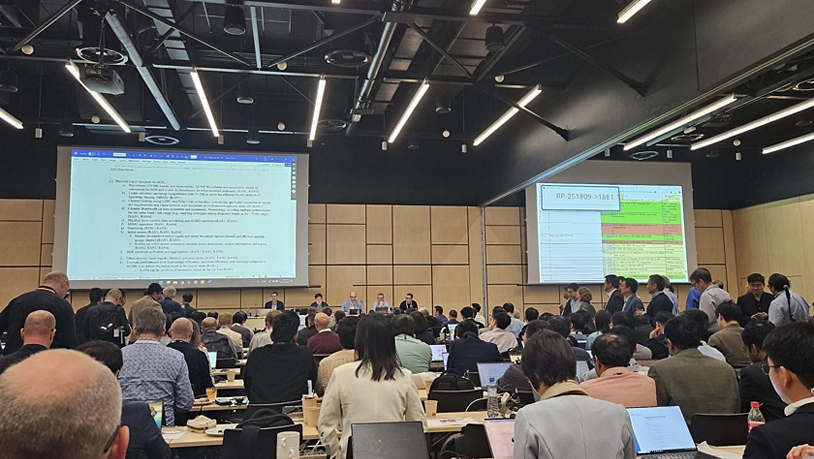
On the week of June 9th, the cellular ecosystem convened in Prague, Czech Republic, for the 108th 3GPP Plenary meeting to chart the future of cellular technology standards. After a week of intensive and productive discussions, many key decisions and milestones were reached. Perhaps the most significant one was the agreement on the initial scope of 3GPP Release 20, which will pave the way for the next generation of wireless technology advancements.
3GPP Release 20 will cover a wide range of wireless topics, further propelling the 5G evolution and laying the foundation for the future 6G standard. For 5G, it marks the 6th technology standard release for 5G Advanced, introducing meaningful enhancements to existing 5G use cases and deployments. This release not only refines current system design but also expands 5G into new and innovative applications. For 6G, it defines the official technical study projects that will focus on foundational wireless technology areas crucial for the 6G Work Items expected in the subsequent standard, 3GPP Release 21.
I am the lead for global 3GPP standards at Qualcomm Technologies, and our team has played a pivotal role in driving innovations and facilitating discussions to reach these important decisions. In this blog post, I’ll provide an overview of the high-level details of this release, covering both the continued 5G Advanced evolution and the 6G Study Item scope.
3GPP is starting detailed studies on 6G that are expected to lead to the first release of 6G standards as part of Release 21. Additionally, Release 20 will continue to enhance 5G in the third release of 5G Advanced. At Qualcomm Technologies, we are thrilled to closely collaborate with the entire wireless ecosystem to lead the world to the next era of wireless communications.
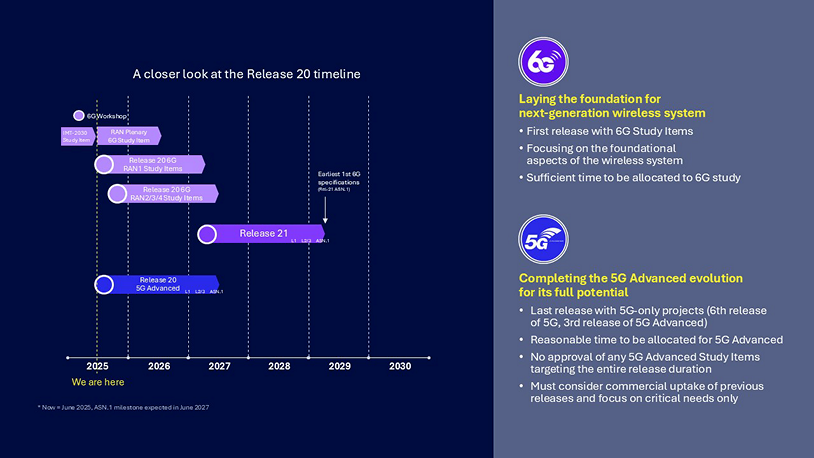
5G Advanced: Delivering meaningful technology refinements to enhance system operations and user experiences
For 5G Advanced, we are continuing to refine the end-to-end system design to unlock its full potential. As we entered the discussions for Release 20, three key principles were agreed upon for the upcoming standard:
- Sufficient time allocation: The release should allocate enough time units (TUs) to 5G Advanced projects to ensure meaningful system enhancements can be made.
- Immediate impact: No 5G Advanced Study Items will be approved that target the entire release duration. This means that all work must be completed within Release 20 and not deferred to future releases.
- Commercial focus: Proposals and potential projects must consider the commercial uptake of previous releases and focus on addressing critical needs only.
Keeping these principles in mind, a carefully selected initial set of 5G Advanced projects were discussed and approved. These projects include Work Items that will further solidify the 5G system foundation, as well as those that will enhance 5G Advanced use cases and large-scale deployments. Here is a summary of the different projects.
- MIMO evolution: Consistent with operators’ demand and as has become usual practice for every 5G standard release, MIMO will undergo further optimization to improve performance and efficiency. In Release 20, enhancements will focus on improving uplink sounding, reducing CSI-RS overhead for large number of antenna ports and enabling early triggering of SRS, CSI-RS and CSI for devices transitioning from IDLE/INACTIVE to CONNECTED mode, as well as for SCell activation and switching out of SCell dormancy in CONNECTED mode.
- Device mobility enhancement: In Release 20, two 5G Advanced projects will enhance device mobility. The first project will further optimize lower-layer mobility (LTM) to reduce cell switching delays, building on traditional approaches. The second project will provide normative support for the AI techniques studied in Release 19 to predict and manage mobility measurements and events more effectively and efficiently.
- Coverage extension: The project focuses on enhancing uplink performance for improved initial access and uplink data channel to meet the demand for a better-quality experience.
- Wireless AI evolution: Release 20 will build on 5G Advanced wireless AI framework and use cases. The AI air interface Release 20 project will focus on the specification support for CSI compression with two-sided models as well as for standards-based device data collection, while the AI for next-generation RAN project will study new mobility use cases.
- Non-terrestrial network (NTN) enhancements: Both NR-NTN and IoT-NTN will have some important improvements in Release 20. GNSS availability has been a key assumption made for NTN operation thus far. The Release 20 NR-NTN project will assess the impact of not relying on GNSS information for initial access and connected mode procedures. After a one-year study, 3GPP will decide how to proceed. In turn, the IoT-NTN project will specify radio improvements to enable voice support for geostationary (GEO) satellite systems.
- Ambient IoT: Following the first release of ambient IoT where passive devices in an indoor topology where the reader functionality is assumed to be at the base station which directly communicates to tags, Release 20 will evolve Ambient IoT in a couple of ways. In the first part of the release, necessary and feasible changes will be studied to support ambient IoT in outdoor scenarios. The second part of the release will focus on providing normative support for active devices leveraging Release 19 and extending to topologies where the device acts as a reader. Whether or not support for outdoors scenarios is included in the normative phase of the project will be decided upon completion of the study.
- Extended reality (XR): The focus is on studying transmission characteristics of mobile AI and specifying RAN protocol enhancements (e.g., mobile AI awareness, a packet data unit (PDU) set for mobile AI data) to better support it, as well as exploring coordination between the gNodeB and core network to ensure lower latency.
- Integrated sensing & communication (ISAC): To prepare for future specifications that support RF sensing, the study will primarily evaluate monostatic gNodeB sensing for drones, including network architecture, procedures, and signaling between the gNodeB and core network.
- Other enhancements: Release 20 will further improve self-organizing network (SON) and minimization of drive testing (MDT), drone communications and more.
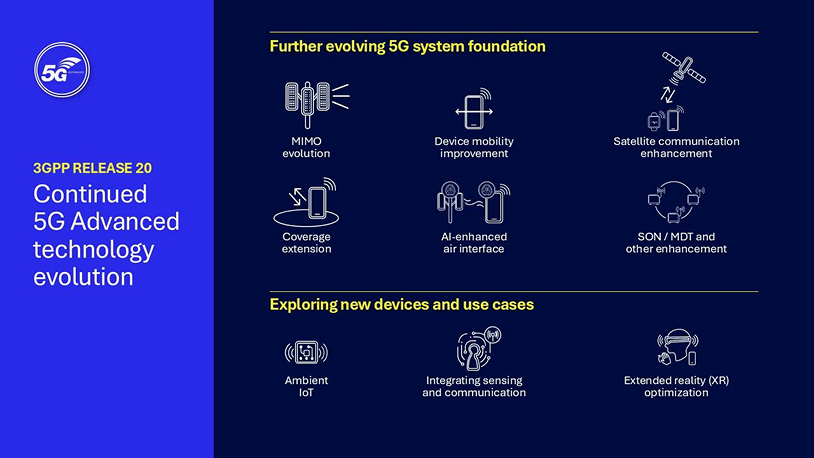
6G: Exploring core wireless innovation and new system architecture to prepare for the future of wireless connectivity
6G presents a once-every-decade opportunity to develop a globally interoperable wireless platform that will drive innovations for our society. It is envisioned to deliver the best possible user experience, system performance and efficiency by leveraging the latest technology enablers such as AI and digital twins. While 6G commercialization is expected around 2030, advanced research to enable this new wireless generation began earlier this decade. Release 20 officially launches the 6G technical Study Item, and the 3GPP companies have agreed on several key study objectives:
- New technology platform: 6G radio (6GR) access technology will support a wide range of use cases and provide the opportunity to use the latest technological enhancements in communications without the constraints of the 5G NR platform.
- Pragmatic approach: 6G should define support for an appropriate set of functionalities, minimizing the adoption of multiple options for the same functionality, focusing on practical user experience.
- Performance focus: The study should explore principles that allow 6G to be scalable and extensible to new applications, deployments and user experiences, while delivering superior performance.
- Spectrum focus: 6GR access should focus on supporting spectrum range up to 52.6GHz, including FR1 (up to 7.125GHz), FR2-1 (24.25–52.6GHz) and FR3 (7.125–25.25 GHz).
Following extensive discussions and negotiations in both online and offline sessions, the 6GR study scope has been agreed upon to encompass key areas of foundational wireless technology design. Here is a summary.
Technology framework: Drawing from the lessons of 5G deployments, the 3GPP consensus is that 6GR should adopt a standalone (SA) architecture with a simplified system design. This approach will support both existing and new services, meeting diverse usage scenarios, requirements, deployments and design principles. Figure 3 captures the key aspects of this standardization framework.

Physical layer structure: An essential part of the 6GR study is the overall physical layer structure. This is expected to feature improved OFDM-based waveforms and modulations, a unified frame structure for 5G-6G spectrum sharing, numerology for wider bandwidths, efficient initial access, synchronization and broadcast signals, evolved channel coding and enhanced MIMO and duplexing. For more details, see Figure 4.
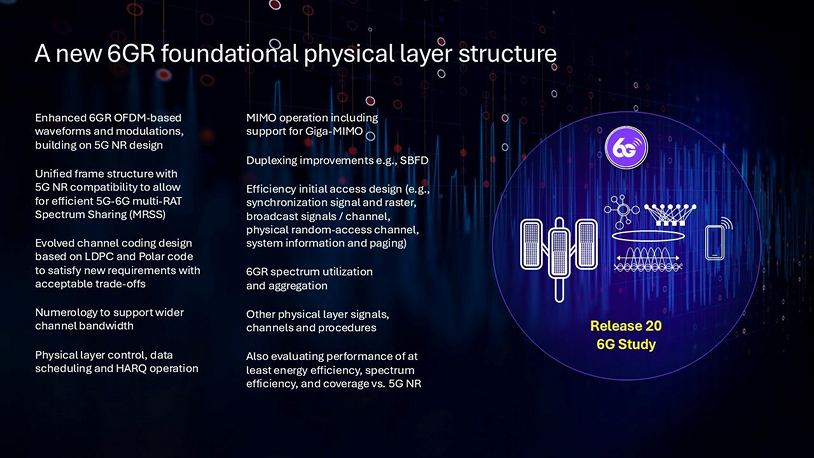
Radio interface architecture: Another key study area focuses on the 6GR interface, protocol architecture and procedures. This encompasses the design of the 6G user and control planes, access and non-access strata, radio resource management, RAN architecture and mobility. The overarching principle is to build upon the 5G architecture, enhancing performance and introducing new efficiencies.
End-to-end RF design: The study covers RF system parameters (e.g., channel raster, synchronization raster), handling of diverse channel bandwidths and coexistence. It also includes both 6G-NodeB and device RF requirements, including core and performance specification structure, a simplified RF requirement framework and testability, among others.
Migration, interworking, mobility: As anticipated, this is a critical component of the 6GR study, focusing on 5G-6G spectrum sharing. It builds on learning from 5G dynamic spectrum sharing (DSS) and potentially includes additional aggregation mechanisms. The study also examines mobility between 5G NR and 6G NR.
Wireless AI: 6G is expected to feature an AI-native architecture, enabling autonomous AI operation between devices and the network across all layers. The initial 6G study focuses on identifying compelling use cases and designing an extensible wireless AI framework, including lifecycle management, and data collection and management. The design will also ensure having an operational fallback without AI.
RF sensing: 6GR is expected to support environmental sensing, which can enhance network efficiency and enable new applications such as drone detection. The study will identify use cases, deployment scenarios and performance requirements, and will evaluate system architectures that integrate sensing and communication, along with physical layer functions and procedures (e.g., waveforms, reference signals).
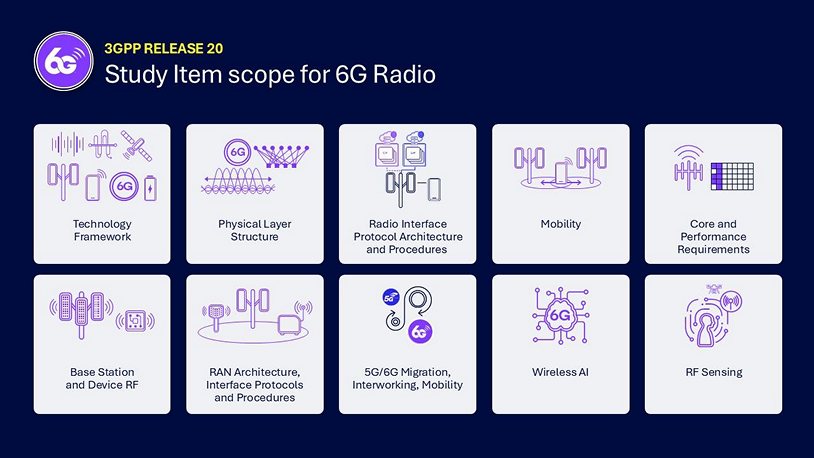
What’s next?
As we officially set the scope for 3GPP Release 20, encompassing both 5G Advanced and 6G, the road ahead is filled with exciting challenges and opportunities. For 6G, we anticipate the study item to kick off in the physical layer working group (RAN1) in August followed by other working groups later in the year. Our team at Qualcomm Technologies is gearing up for a productive and collaborative journey with the entire wireless ecosystem to ensure the 6G study is both smooth and effective. On the 5G Advanced front, we are confident that the work on Release 19 is progressing smoothly. We expect the specification functional freeze in September, followed by the ASN.1 milestone in December. I will be sure to provide another update as these milestones are reached, so stay tuned for more exciting developments.
Download the 3GPP Release 20 presentation
Learn more about the future of wireless technology — check out our 6G website
Sign up for our wireless technologies newsletter to stay up to date

